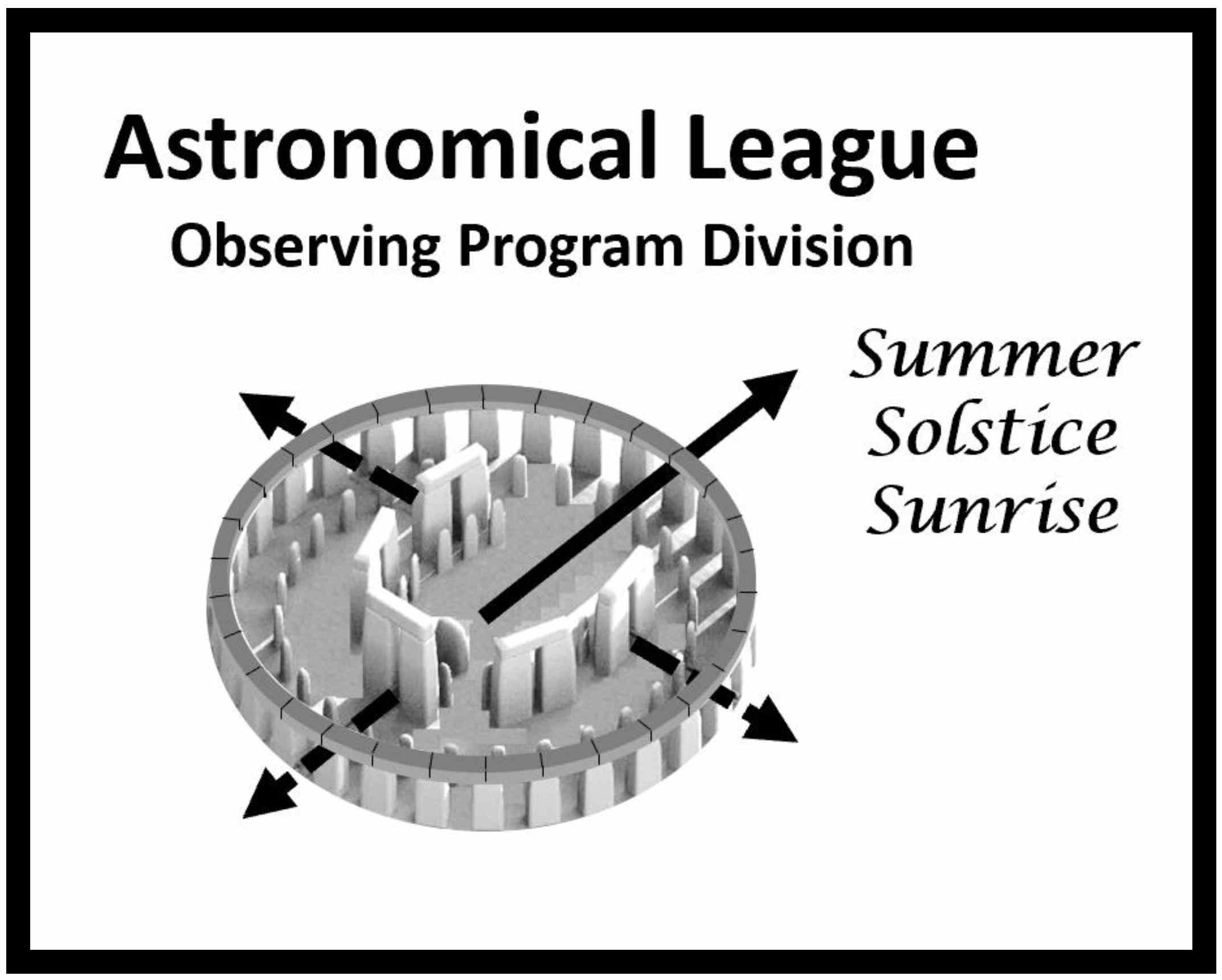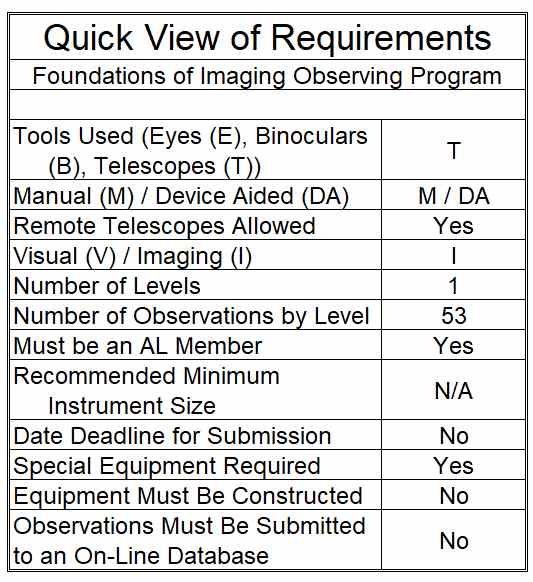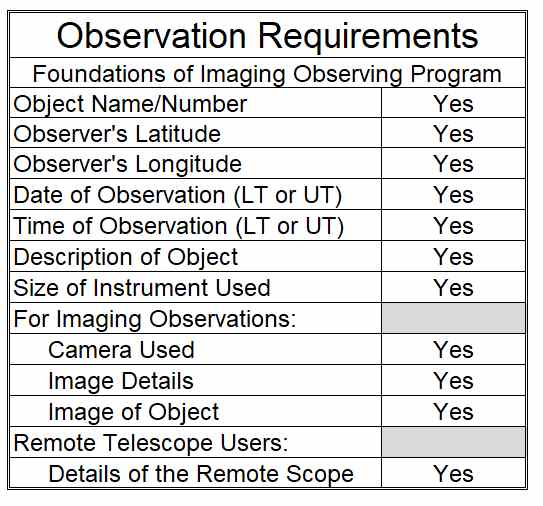Foundations of Imaging Observing Program Coordinator:Dan Crowson |
 |
IntroductionAmateur astronomy has long embraced three distinct passions: amateur telescope-making (ATM), eyepiece-based observing, and astrophotography. In earlier days, astrophotographers spent countless hours peering through reticule eyepieces manually correcting guiding errors and capturing astronomical images on film. An airplane or satellite might well have ruined an exposure. Today a new generation of astrophotographers use automation, autoguiding, digital photography, and post-processing to improve the image to a point to which early imagers could only dream. The technology required to produce fascinating images of our universe has advanced rapidly over the past several years. The equipment has become more affordable, while the internet has enabled individuals to learn the technology and share their images with the world. Astrophotography is an activity that sparks much interest among many Astronomical League members; it surpasses visual observing in some clubs. |
 |
Amateur astronomers take images for three main purposes or objectives:
-
- to create Artistic images, in the vein of Astronomy Picture of the Day (non-linear data),
- to aid in Observing things that are beyond the range of the human eye (linear or nonlinear data),
- to collect Scientific Data that extends the bounds of astronomical knowledge (linear data).
The Fundamentals of Imaging Program is designed to give the participant a chance to experience all three of these different purposes with a wide range of targets.
Requirements and Rules
This certification is available to members of the Astronomical League, either through their local astronomical society or as members at large. If you are not a member and would like to become one, check with your local astronomical society, search for a local society on the Astronomical League Website, or join as a Member-at-Large
Imaging Targets:Experienced imagers seem to develop favored targets. Some specialize in Deep Sky Objects, while others might enjoy comet, planetary, Lunar, or Solar imaging more. Each of these specialties requires somewhat different equipment and methods and presents different problems for the astrophotographer. The Fundamentals of Imaging Program will give the astrophotographer an opportunity to explore a wide range of targets in these areas of specialization:
|
 |
Equipment:
Currently, a number of the Astronomical League observing clubs allow the use of imaging techniques as an alternative to observing objects visually with the participant’s eyes. These clubs were designed to introduce participants to a variety of astronomical objects, to improve their visual skills, and to increase their knowledge of astronomy. Astrophotography requires somewhat different equipment and techniques than visual observation. Participants will need a good background in computer technology and should be able to learn a variety of imaging and processing techniques. To keep up with the level of the technology and to provide new challenges for the participants, the imaging programs will be evaluated and adjusted periodically to keep pace with technological advances.
The wide range of targets and activities of the Fundamentals of Imaging Program will require a wide range of equipment. The imaging equipment required will run from a DSLR with a wide-field lens to a CCD or CMOS camera mounted on a telescope. The camera and associated software should have the ability to save both individual frames and video files. Mounts should have the ability to track and even be autoguided. Plate solving and astrometry should be explored.
Certain targets imaged in the Program will require specialized equipment. The Sun will be imaged in white light or Hydrogen-Alpha.
Imaging Activities:
Solar System: [twenty-seven images total] (see Appendix 1: Brighter Solar System Objects for details, hints, and tips)
Note: Solar observing can be dangerous to the eyes and equipment. Use Safe solar viewing practices when imaging the Sun, and when imaging Mercury and Venus when they are close to the Sun.
- Image the entire solar disk showing sunspots with a white light filter OR a hydrogen-alpha telescope. [One image]
- Image and label solar details mentioned in either the Astronomical League’s Sunspotter Observing Program (white light with a suitable filter) or the Astronomical League’s Hydrogen-Alpha Observing Program. [One image]
- Image the entire lunar disk. Depending on your equipment a mosaic may be required to capture the entire disk. [One image]
- Image in detail any seven of the lunar features mentioned in either the Astronomical League’s Lunar or Lunar II Observing Programs. One of the images should show both a crater and a dome. While an image may have several features, seven images must be submitted, each highlighting a particular feature. [Seven images]
- As the terminator sweeps across the Moon’s surface the changing light and shadows can create interesting temporary shapes like the Lunar-X or Lunar-V. These are called Clair-lunar effects. Image the Lunar-X and Lunar-V. The final product may be either a single image or a time-lapse video (AVI, SER, etc.) of the event. [Two images]
- Image Saturn, Mars and Venus (pick two of the three). Saturn should show detail as should Mars if imaged near opposition. Venus goes through phases and may not appear round. [Two images]
- Image Jupiter showing the Great Red Spot (GRS). [One image]
- Image Jupiter showing a satellite transit, an occultation, an eclipse, and a shadow transit. Be sure to include the name of the satellite and event. Images with multiple events are permissible and even encouraged. [Four images]
- Image dwarf planets Pluto and Ceres (or other dwarf planets) twice over a one to two-month period and identify them in the field. Measure and report their positions (RA/Dec). [Four images]
- Image a comet over the period of one to two nights to show motion through the sky. Measure and report the positions (RA/Dec). Due to the nature of comets please see Appendix 2 for details, hints, and tips. [Two images]
- Image an asteroid over the period of one night to two nights to show motion through the sky. Measure and report the positions (RA/Dec). Due to the nature of asteroids please see Appendix 2 for details, hints, and tips. [Two images]
- OPTIONAL: Image a solar eclipse showing C1-C4 contacts. The final product may be either a single image, a time lapse video (AVI, SER, etc.) or a collage image of the event. [Four images—replace any one of the eleven requirements above]
- OPTIONAL: Image a lunar eclipse. The final product should be a time-lapse video (AVI, SER, etc.) or collage image of the event. [One image—replace any one of the eleven requirements above]
- OPTIONAL: Submit at least five wide-field images with elements as follows (not all elements are required): identifiable in focus foreground and the night sky, Milky Way, a constellation out to its border, star trails, time-lapse video. [Five images—to replace any one of the eleven requirements above]
- OPTIONAL: Image three lunar occultations (one ingress, one egress and one graze). The final product should be a time-lapse video (AVI, SER, etc.) of the event. Stacking is not required for occultation images. If possible, include a time stamp on the frames to time the event. [Three images—replace any one of the eleven requirements above]
Deep Sky Objects: [twenty-five images total] (see Appendix: 2 Deep Sky Objects for details, hints, and tips)
- Image at least twenty-five deep sky objects.
- The images should include at least two objects in each of the following types:
- Open clusters
- Globular clusters
- Dark nebulae
- Galaxies
- Bright nebulae must include at least one of each of the following:
- Star-forming regions, including the Bok Globules (e.g. M42, M16),
- Reflection nebulae (e.g. M78, NGC 7023)
- Planetary nebulae (e.g. M57, M27), and
- Supernova remnants (e.g. M1, NGC 6960)
- You may consult existing AL observing programs for suggestions. While you may submit images with multiple objects, at least twenty-five different images must be submitted.
- You must include M42 and M31 in the objects imaged (these may count as one of the two objects needed for a particular type). These objects were chosen because of their popularity and the hurdles needed to produce a good image.
- M42 must show the Trapezium not overexposed and the surrounding wispy nebulosity.
- M31 should show the dust lanes, proper color, and must not have an overblown central core.
- The idea is to show growth as you progress through the images as you become more proficient with the setup and operation of your equipment, making exposures, calibrating, stacking, and post-processing to achieve the best final result.
2. OPTIONAL: Image five double stars from the Astronomical League’s Double Star Program. From these images measure the position angle and separation between the primary and secondary. (See recent editions of the Journal of Double Star Observations for ways to accomplish this.) [Five images—replaces 5 DSOs]
3. OPTIONAL: Select two variable stars from the A.A.V.S.O.’s Variable Star Index or Variable Star Target Tool and follow them over a period of two months using proper cadence. Use photometry to measure the changing brightness over the period. The A.A.V.S.O. has links to their DSLR, CCD, and Visual Observing Manuals here. The manuals are a great introduction to variable star imaging.
Note: Consult the A.A.V.S.O.s Light Curve Generator to make sure your chosen variable stars will actually vary over your time period. [Ten images—replaces 5 DSOs]
4. OPTIONAL: Image a nova or a supernova at least twice over a suitable time period to show a change in brightness. Estimate the brightness in each image based on surrounding stars. [Two images—replace two DSOs]
For all of your images include:
- Date and time for the beginning of exposure in UT or LT
- Latitude and Longitude
- Seeing and Transparency
- Telescopes and Optics used
- Mount used (and any special tracking concerns)
- Cameras used
- Exposure information (number of exposures/length of exposures)
- Filters used
- Field of View
- North and east or west must be indicated on or with the images or videos,
- Software used to calibrate, stack, and post-process,
- Any additional comments you feel necessary to document your work.
Imaging Criteria:
There is no hard rule for the number of exposures or total length of exposure required for the activities in this Program, but each submitted product should be a calibrated stack of processed images.
Your final images should have in-focus, round stars without excessive bloat. The subject must be in-focus, clearly portrayed, without distracting artifacts (excessive noise, star bloat, highlights clipping, excessive vignetting, obvious gradients, collimation errors, hot pixels, etc.), and appear natural, that is, not too overprocessed. A corner coma is acceptable if you don’t have corrected optics. The colors should be as accurate as allowed with your equipment and if possible, be gradient and generally noise-free. Images that result from multiple exposures from either mosaics or exposure blending should not have any process artifacts. Stars should never be green (this is a blight caused by improper color editing of images captured with narrowband filtration.) Directly editing the pixels of the image is allowed if the result enhances the clarity of the subject and is largely undetectable. You are not required to own the equipment used, but you must be the primary agent in the planning, setup, capture, and editing of each image. Tools like eXcalibrator, G2V and PixInsight’s Photometric Calibration Tool can be a great help with these concerns. As much as possible, use an appropriate instrument combination to collect the data. An equipment combination that nicely frames M31 will not have much success with Jupiter.
The images must be submitted in high-quality JPEG, PNG, or BMP format with the following standards:
- At least 1000 pixels along one edge
- sRGB color space
- In either OSC/LRGB “natural” color, or narrowband false color. False color should be one of the following standards: HOS (normal false color), SHO (Hubble false color), or HOO (star-forming regions)
You are encouraged to submit your best images to the Reflector magazine for publication – photoeditor@astroleague.org
Submitting for Certification
Upon completion of the Program’s activities assemble your images and data into a suitable format for either paper or electronic submission. The fifty-two images and associated documentation will be huge so direct emailing of a zipped file will be impossible. Possibilities for submission might include:
- Assemble your work into a PDF, spreadsheet, or other document with the required information and links. Use file sharing via DropBox, Google Drive, OneSite, iCloud, or another appropriate site.
- Upload your images to a folder in an online photo-sharing website such as astrobin.com ($$$), flickr.com (free), imgur.com (free), or shutterfly.com (free). Include the date, time, latitude, longitude, etc., in the comments for each photo,
- Create a web page with the images, videos, and required information.
Activities requiring videos will need to include the URL of the shared file. However you choose to submit the required images and information, please take the time to make sure the coordinator can identify your images with respect to the task they are intended to fulfill.
To receive your Fundamentals of Imaging Observing Program certificate and pin, send your report or the URL via email or post to the Program Coordinator for verification. I prefer to verify the observations myself since I really love to see what other folks have done. However, if mailing the observations seems impractical and there is another member in your club who has already received the Fundamentals of Imaging Observing Program certification, I will accept a recommendation from that person. DVDs or materials will not be returned. If there are any questions or problems please contact the Program Coordinator by mail, phone, or email.
Fundamentals of Imaging Observing Program Coordinator:Dan Crowson |
 |
Notes:
Acknowledgements:
- The Astronomical League thanks the developers of this Observing Award: Dan Crowson—Astronomical Society of Eastern Missouri, Robert S. Brayton, Cr.Photog., CPP North Houston Astronomy Club, and Steve Boerner—Member-at-Large for their work to make this Program possible.
- The tools for imaging are constantly changing. If you discover and have success with other imaging tools for Windows or another OS, let the program coordinator know and we’ll update the information presented in Appendix 3: Imaging Software.



